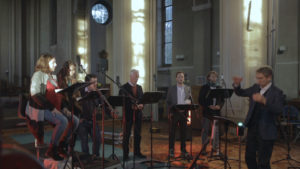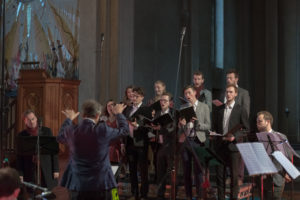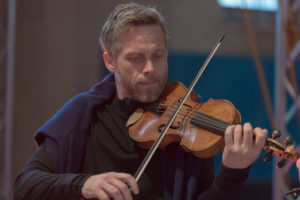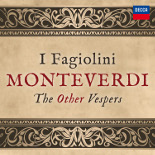
Recording Beatus Vir
Monteverdi’s famous 1610 collection referred to as ‘The Monteverdi Vespers’ (not the subject of this recording) contains a mass, music for Vespers and motets for one and more voices. Not a single record survives of contemporary performances of the collection, nor is it certain that Monteverdi intended it as a single, coherent set of Vespers settings; but its psalms, Magnificat and motets have for at least 50 years been an iconic 17th century performance piece.
For reasons unconnected with musical quality, that collection has dwarfed Monteverdi’s other church music, which he probably continued to write throughout his life. Much of it was it gathered together in a fabulous volume called ‘Selva morale e[t] spirituale’ – ‘the moral and spiritual wood’. It was published in 1641, and likewise contains a Mass, music for Vespers (the two services most commonly celebrated with music) and solo-voice motets. On purely practical grounds it is strange that this later volume has not done better, given that it contains more music manageable by an average choir (as well as highly virtuosic items) and offers a greater choice. For an early 17th century choirmaster it would have been a perfect complement to the earlier volume: while 1610 is suitable for feasts of the Virgin or other female saints, 1641 contains the psalms for feasts of male saints.
So the purpose of this recording in Monteverdi’s 450th anniversary year (and I Fagiolini’s own 30th) is to draw attention to the sheer brilliance of these works, encouraging choirs and listeners into the woods (moral and spiritual) in search of a fuller picture of Monteverdi. It also re-imagines the sole recorded instance we have of Monteverdi directing the music for a Vespers in Venice: a Dutch tourist saw him moonlighting in a Vespers away from St Mark’s on June 24th, 1620 – the feast of the Nativity of St John the Baptist. We have provided the liturgy for that feast with psalms taken from the 1641 collection, aware that many of them would have been written long before that date.
For those who don’t attend Vespers every day, the essential musical items are:
Opening call & response
5 psalms
Hymn
Magnificat

Recording Gabrieli’s Magnificat a 14
Psalms and Magnificat are framed by short plainsong antiphons specific to the feast/season but it was common practice in early 17th century Northern Italy to replace their repeat with other suitable musical items (while the priest spoke the text). To the puritan this was an abuse that turned services into concerts: to the enthusiast it was a stimulus to devotion. For these items we have chosen particularly intriguing substitutes by Monteverdi’s contemporaries. Virtuoso singer Bovicelli’s ornamental take on a Palestrina madrigal is sanctioned by the sacred text Bovicelli adapted to his version: the resulting sound of voices and cornetto muto is other-worldly. Donati (whose own Vespers psalms were published in 1623) sets the text ‘Jesus, my sweet love, pierce me with your arrows’ as sensually as Monteverdi set similar texts in 1610. (This sort of extreme intensity was reflected in others arts, notably Bernini’s 1652 statue of The Ecstasy of St. Teresa.) There are instrumental fantasies by Castello and Frescobaldi, and a luxurious sonata by Usper, who collaborated with Monteverdi on a Requiem Mass in 1621.

Bjarte Eike
The opening Response is by Viadana, whom Monteverdi knew from their time at Mantua (and whose Vesper psalms are recorded on our ‘1612 Italian Vespers’). The only split-choir item is a Magnificat by Giovanni Gabrieli, second organist (but premier composer) at St Mark’s until his death in 1612. Gabrieli was still very much in vogue in the Venice of 1620 and so our celebration looks back as well as forward, much like Monteverdi’s own sacred music. At the conclusion of Vespers one of the seasonal Marian antiphons would be sung. We offer Monteverdi’s rarely-heard 1624 ‘Salve, O Regina’, whose anguished, expostulatory text is a self-troping expansion of the traditional ‘Salve Regina’.
My own introduction to this repertoire was partially through Andrew Parrott and the Taverner Consort’s recordings in the 1980s. Parrott’s combination of music-making alongside his unstinting quest to challenge accepted truths with evidence which changes the character of pieces we thought we knew make him a musical hero of mine so I hope this recording might serve as a respectful hommage. In that spirit, we offer some new ideas on performance practice, notably (1) the improvised cornetto ornamentation in the opening movement (as recommended by Schütz for a similar passage in his Weihnachtshistorie) and (2) reading the triple time signatures as indicating a slower tempo relative to the duple than is generally heard in performance. (More on this here.) If this sounds like the sort of detail of interest only to specialists, the implications are actually profound, affecting the basic character of the pieces, the performers’ phrasing and the style of ornamentation.

Matthew Long, Nicholas Mulroy
Of course musicological conclusions of this sort should not be an end in itself but an inspiration to performers. So in a business over-focussed on directors, it seems appropriate to highlight a few individual contributions. Violinist Bjarte Eike catches the rhapsodic mood of Castello’s virtuosity like a leaf in the wind: it’s the sort of performance that makes you understand what contemporary writers meant when they talked about taste. In a similar way, cornettists Gawain and Andrea ornament with a technical and stylistic freedom which left me (in the words of Constantijn Huygens, the Dutch tourist) ‘ravissement hors de moi’ [besides myself with pleasure]. And it has been a particular joy to record Monteverdi with singers with whom I’ve worked for years on his madrigals and L’Orfeo. To single out just two of them, hearing Nicholas Mulroy and Matthew Long improvise different embellishments on every take may have made editing difficult but it says a lot for their understanding and ‘feel’ for this music. Another pleasure was to involve my own students from the University of York, bringing on the next generation.
Robert Hollingworth January 2017
